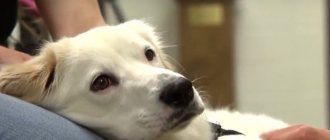Every animal needs love and affection, as well as full satisfaction of natural needs. That is, the availability of food and water, the opportunity to walk in the fresh air, meet relatives and reproduce. It is the last question that is often most pressing. It’s one thing if your pet is a show winner and there’s a queue for puppies. And it’s completely different if it’s an ordinary mongrel. In this case, sterilization will be a good solution to forever forget about the problem of adding offspring.
Specifics of the problem
If natural needs are not fully satisfied, the animal will experience discomfort. At the same time, if you do not plan to burden yourself with caring for the kids, then try not to let the dog go far from you during a walk during the period of heat. The male will have to be constantly monitored, especially if there are females walking nearby. Having bred your pet once, you will have to constantly look for partners for it or sterilize it.
Lack of mating can negatively affect the dog’s health and its nervous system. Therefore, in the modern world, many owners prefer sterilization. In addition, practice shows that this process has a beneficial effect on the gynecology of the animal. After sterilization, the dog’s behavior becomes calmer and more measured. He doesn't break the leash during walks and plays with a ball like a puppy.
What you need to know about spaying and neutering Yorkies
It is generally accepted that male Yorkies are castrated and female Yorkies are sterilized. However, in reality the picture is completely different. Both operations are applicable to dogs of both sexes, but there are certain differences.
When sterilized, pets are deprived of reproductive function, but it is reversible. All organs of the reproductive system are not removed; the production of sex hormones in animals continues. But at the same time, the seminal flows of males are tied, and the fallopian tubes of females are tied. Subsequently, upon the owner’s request, a second operation can be performed, which will allow the pet to reproduce.
But castration is a more serious procedure.
After it is carried out, animals are irrevocably deprived of the opportunity to reproduce offspring. For reference! During surgery, the dog's genitals are simply removed, in whole or in part. Subsequently, testosterone and estrogen are synthesized in smaller quantities, which is why the sexual desire in dogs disappears.
Animal age
Doctors have different opinions on this matter. Most experts say that the operation can be performed after reaching six months of age. Not in some groups it is recommended already in the second month of life. Operations that are carried out before the first heat end especially favorably. They help to avoid many problems in the future and reduce the risk of developing tumor processes. The only requirement is that the animal must be completely healthy at the time of surgery.
A dog's behavior changes for the better after sterilization. Hormones no longer affect it, so the animal becomes more obedient and affectionate. At first glance, this method seems cruel. After all, you will have to deprive your pet of the opportunity to reproduce to suit its needs. But try once to feed a pregnant bitch, care for the puppies, and then find a loving family for each of them and you will understand that it is not so easy.
There is another important point here. A dog's behavior after sterilization changes noticeably if the operation was performed at an early age. Therefore, it is advisable to do it before the first heat. If the bitch has already been bred, then periodic bursts of aggression and disobedience may persist. Everything here is individual, a lot depends on the character of the dog.
Do you need medications and what kind?
Only the doctor who performed the operation can prescribe medication for a male dog after castration. Sometimes I don’t prescribe anything - if the dog was young and the incision turned out to be tiny. At the clinic, the dog receives a painkiller that lasts for 24 hours and a long-acting antibiotic. If the operation was performed in a sterile operating room, this is enough.
If castration was performed for medical reasons (for example, prostatitis), or there was an intervention in the abdominal cavity (cryptorchid), a course of antibiotics may be required.
Painkillers are also prescribed at the discretion of the doctor for the first 1-3 days after surgery.
Most dogs show no signs of pain after surgery
Main advantages
Modern research shows that this operation has many more advantages than disadvantages. Moreover, there are benefits for both owners and their pets. The dog’s behavior after sterilization may not change if the bitch was docile and affectionate. But besides this, there are a number of advantages that the veterinarian pays attention to.
This procedure prevents unwanted offspring and reduces the chance of breast cancer. Estrus itself is also not the most desirable phenomenon. If the dog lives at home, then blood stains remain on the carpets and upholstery of upholstered furniture, especially if it is used to sleeping on the sofa.
Danger signs
Many owners are interested in whether it is possible to sterilize a bitch after mating. It is not advisable to do this, but if there is no choice, for example, due to vital signs, then an experienced surgeon will perform the operation.
Sometimes owners are worried because after sterilization the dog’s milk appears, the mammary glands become enlarged, or discharge appears as if in estrus. This is due to the fact that there are still sex hormones in the bitch’s body.
It is much more dangerous if swelling and a lump appear on the seam. It could be a hernia. To prevent this from happening, you need a blanket and limiting the dog’s excessive mobility.
It is even more difficult if part of the seam does not heal and a fistula forms. In such a situation, an urgent visit to a veterinary clinic is necessary.
All owners are frightened if the dog behaves differently than before: it has become aggressive, is afraid of everyone, is nervous, hides in a corner. This may be a manifestation of a difficult recovery from anesthesia and should go away on its own. Owners will need to show patience and kindness to their pet.
Impact on character
Sometimes owners come to the veterinarian with requests for sterilization, expecting a miracle from her. That an ill-mannered, aggressive or hyperactive pet will become imposing, calm and obedient. In fact, a dog does not change that much after a sterilization operation. Her character will remain the same, as well as her upbringing, which depends solely on you.
If we talk about behavior, more serious changes can be observed in males. A female dog only comes into heat twice a year, so her brain is not constantly under the influence of hormones. If you have several dogs, then you need to take into account that in nature the female sex dominates the male. After the operation, this quality will double, so you need to be prepared for possible conflicts, especially if the male has not been neutered. That is, we can say that the dog’s character does not change in principle after sterilization.
Scrotal swelling
If there are no medical indications, then the scrotum is not removed during castration of a male dog. Immediately after surgery, this leather pouch remains empty. Doctors may briefly apply a heating pad with ice to the scrotum to cause the blood vessels to constrict.
Don't worry about the aesthetic side of the issue - in a few months the skin will magically tighten. There will be a smooth place where the testicles were.
Bulldog after castration
True, this takes time. But the body does not tolerate any emptiness and strives to fill it. Therefore, lymph can accumulate in the scrotum. On the third or fourth day, it looks as if the testes have returned to their place! This is fine.
Sometimes the swelling can be too strong and painful. This happens in several cases:
- Blood clots had accumulated in the scrotum because a vessel was damaged and not ligated.
- The wound became infected and inflammation began.
- Rejection of the suture material occurs (the latter situation is extremely rare; usually the problem is a violation of sterility).
In which case should you see a veterinary surgeon as soon as possible:
- the scrotum is purple or bluish in color;
- the swelling is so strong that the scrotum is larger in size than before the operation, the skin is stretched;
- discomfort when walking in a dog, signs of pain.
The doctor may prescribe novocaine blockades with an antibiotic or systemic antibiotics; sometimes surgical revision of the wound is required (under local anesthesia).
This Labsky (Labrador and Husky mix) was neutered at 7 months.
You can see more photos of Labski HERE (link will open in a new tab)
Important arguments for sterilization
What pushes people to do such an act? First of all, this is done to avoid the appearance of offspring. These operations have other undeniable advantages. Pros of sterilization:
- You can safely walk in the yard without fear of aggression from surrounding males. There will be no gatherings of other people's dogs near your home.
- A sterilized male dog becomes more balanced in his psyche.
- You definitely need to consider the possibility of performing the operation if you also have other pets. This will reduce the risk of conflict situations. At the same time, the problem with the desire to mark territory is being solved.
- The female will maintain her health and will be protected from sexually transmitted diseases. Dogs have a huge number of them. Imagine how risky a bitch is when surrounded by a pack of males. Diseases of the reproductive organs can cause a deterioration in the quality of life and early death of your pet.
- The life of a pet will be several years longer.
- He will be easier to train.
- Finally, when considering the pros and cons of sterilization, it should be noted that it is protection against unplanned offspring. This is the most humane way to reduce the number of mongrels, who very often become homeless solely due to human fault.
As you can see, there are many positive aspects to this. But when owners are interested in how much it costs to sterilize a dog, many refuse such an idea. This is an abdominal operation that cannot be free. But almost every city has preferential sterilization points. They are designed primarily for homeless animals. Therefore, if a common favorite has settled in your yard and everyone feeds it, then you should think about preventing it from starting to bear offspring. Only at first glance there is nothing wrong with this. After all, puppies will suffer from cold and hunger, and children may offend them. A dog that lives in such conditions cannot eat properly, and at the same time, feeding the offspring will lead to exhaustion of the puppies. What will happen to the babies later if no one takes them?
Contraindications for castration
Contraindications to surgery in dogs may include the following:
- Lack of comprehensive vaccination or a short period after vaccination (less than a month);
- Without certain medical indications: age, operations are not recommended for dogs under 5 months or older than 6 years;
- Kidney pathology, diseases of the cardiovascular system, in which anesthesia is contraindicated;
- Unsatisfactory clinical condition, loss of appetite, increased body temperature, hair loss or dull color, depressed state;
- The presence of severe infectious diseases;
- Age at the time of surgery matters: older dogs may have contraindications to surgery, often associated with chronic diseases.
As a rule, no tests are required, but tests can be carried out at the request of the owner or at the request of the veterinarian in controversial cases of the clinical condition. Research can show whether neutering is dangerous for a dog or whether the surgery can be done.
Main disadvantages
It must be remembered that this is a serious, abdominal operation. You need to prepare for it, as well as for possible side effects. Clinicians should advise caring owners of the pitfalls. These include the following factors:
- This is a surgical operation. Despite all the predictability, it can have dire consequences. Most often this may be due to the low qualifications of the doctor. Without the proper experience, he has every chance of making a mistake, for which the animal will pay not only with health, but also with life.
- The consequences of sterilizing a dog may not always be predictable. Bleeding, infection in the wound, development of inflammatory processes, suture dehiscence - all this can occur after surgery. And this is still an incomplete list.
- Changes in metabolism are something that many owners face. The animal becomes prone to gaining excess weight. A fat dog becomes apathetic, which significantly reduces the time allotted to it.
- After surgery, urinary incontinence may develop. And this leads to chronic pathologies of the urinary system.
- Anesthesia itself has a negative effect on the dog.
- Plus, you need to consider how much it costs to sterilize a dog. The price starts from 4,000 rubles, that is, the amount is not available to all owners.
How does castration of a male dog occur?
The technique for castrating male dogs differs from castrating rabbits or cats; these operations cannot be compared. There is only one general point: if both testicles are in the scrotum (the male is not cryptorchid), then castration is not an abdominal operation.
Why, why are we going to the clinic?
A very important point: the surgeon should not cut the skin of the scrotum. There are many nerve endings and even more blood vessels. The incision is made “along the white line” in front of the scrotum, and both testes are brought out through it. A ligature is applied to the feeding vessel and the spermatic cord, and it slips into the pelvic cavity. The skin wound is sutured.
The suture can be cosmetic (all the threads are inside the skin, gradually dissolving) or removable, external. This depends on the qualifications of the surgeon, the availability of suture material, and also on how the operation goes. I never tell owners in advance what exactly there will be “cosmetics”. It happens that the skin is too loose and separates; sometimes it is necessary to “press” the bleeding vessel of the skin with the external sutures. If removable sutures are placed carefully, they will not create any problems.
The entire operation lasts about 15-20 minutes. But the dog will stay in the operating room longer. This is due to the fact that you need to shave, wash and disinfect the skin, isolate this area with the surgical field, and administer local anesthesia. After the operation, wait until the patient begins to wake up. Only then is the pet taken out to its owners - or placed in a cell in a hospital. How is it accepted where?
Post-operative care
It is best to do it on Friday evening. Then you will have the weekend to watch your pet. The operation is performed under anesthesia, so it takes time for the dog to recover from it. This usually takes from several hours to a day. Adhere to the following rules:
- Place the dog on a flat surface, not high from the floor.
- As soon as she wakes up, give her water.
- Blot the seam with a napkin and treat it with brilliant green.
- Start feeding within 24 hours.
- Make sure she doesn't lick the seam. A bandage is sometimes worn for this purpose.
- On the third day, the dog completely returns to its usual rhythm of life.
- Treatment of the affected area should be carried out for up to 10 days.
Caring for the dog after sterilization is carried out under the supervision of a doctor. If necessary, he prescribes antibiotics.
Dog castration - before and after the procedure
Before the procedure, the veterinarian should order basic tests that will allow the dog to qualify for surgery and evaluate whether it is possible to give him anesthesia. These are morphology, heart and kidney tests, etc. In the case of female dogs, the date of castration is important - surgery is best done 3-4 months after fluid intake. The dog must be healthy, and not immediately after vaccination.
Before surgery, the animal cannot eat or drink anything for 24 hours. The castration procedure does not last long, but requires that the dog remain under the supervision of a veterinarian until he awakens from anesthesia. Do not give food or water to your pet for the first hours after treatment. You also have to watch him so that he doesn't scratch his wounds - for this they wear a special straitjacket or collar. The dog will be weakened, so do not take it outside - it is better to let it deal with any physiological needs at home. It is also worth limiting the animal’s activity for several days, and changing the bandage 1-2 days after the procedure.
Nutrition after sterilization
Owners often say that after surgery the animal becomes more relaxed, sleeps a lot and walks less. In addition, he develops an excellent appetite. The result is rapid weight gain and health problems. You can avoid this by following simple rules. Reduce the calorie intake by 10%, and also monitor your pet’s activity. Today there are special foods for sterilized animals marked Light, that is, light. The composition contains a reduced amount of fat, as well as a lot of fiber.
Preparing to sterilize your Yorkie
Like any other surgical intervention, castration requires careful preparation of the pet. You need to start with a consultation with a veterinarian, certain tests and an ultrasound of the heart. It is recommended that the preoperative examination be carried out in the same clinic where the procedure will be performed in the future, so that the surgeon has a complete clinical picture of the patient.
Only a completely healthy animal can be operated on. Therefore, a couple of weeks before the event, it is necessary to carry out helminth prevention. Vaccinations must be done 3-4 weeks before the procedure. It is prohibited to do this during the postoperative period, since the pet’s immune defense is reduced.
Important! You cannot feed the animal 12 hours before surgery. You should limit your pet's drinking 6 hours before the procedure.
How to sew a bandage
A post-operative bandage can be made at home. It is advisable to have a sewing machine at your disposal. The material from which you are going to make the bandage should be durable, but breathable. If the dog is very active, it is better to use summer jeans.
The pattern is made according to size. Please note that the blanket must be worn on the hind and front legs. If the bandage is not on the hind legs, the dog can easily remove it. The ties should be done on the back. You can use laces, Velcro or buttons for fastening.
The bandage should not squeeze the dog’s body, but it is also highly undesirable for it to dangle. The pattern is an X-shaped pattern. The whole part is the belly. When preparing a pattern, take into account the allowances; the raw edges stretch after the first wash.
When preparing to sterilize your dog, keep in mind that there must be at least two blankets. After washing, the bandage must be ironed. It is not advisable to use household chemicals for washing, even for children.











